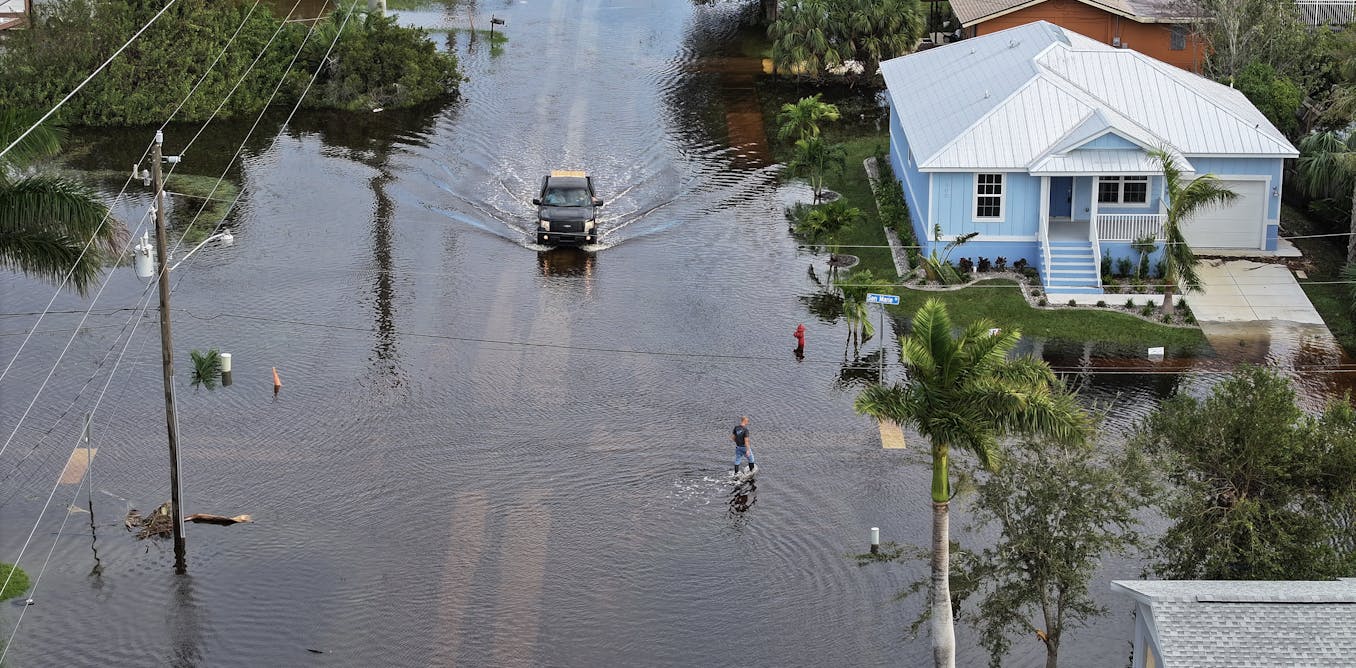The integration of 3D printing with drones in construction is a revolutionary concept that is set to transform the industry. In a recent video, we witnessed the awe-inspiring sight of specialized drones printing 3D structures as they fly. This genius invention combines the precision of 3D manufacturing with the maneuverability of drones, resulting in structures being built with astonishing speed and accuracy.
Traditional construction methods often result in wastage of materials, with up to 30% of materials delivered to building sites ending up in landfills. In contrast, 3D printing in construction only uses the materials required, drawing from locally available and recycled materials. This not only reduces waste but also minimizes pollution from heavy machinery.
The use of drone construction squads can revolutionize the construction industry, enabling the building of shelters in hard-to-reach disaster zones and carrying out repairs at dangerous heights without risking human lives. The collaboration between multiple drones working collectively to 3D print structures showcases the potential for aerial additive manufacturing to change the way we build in the future.
The application of kinematics and robotics in this innovative process is reminiscent of the precise movements of wasps and bees as they create their nests and hives. Inspired by nature, the drone construction squads are guided by the concept of stigma, where the trace left by one action stimulates the next. This groundbreaking technology has the potential to revolutionize construction practices and pave the way for a more sustainable and efficient future.
Watch the video by Ziroth
Video Transcript
Watching specialized drones printing 3D structures as they fly is one of the coolest things I’ve ever seen in this video we’ll see how they do this which is even more fascinating if you’re a fan of this channel you’ll know that I love 3D printing drone Innovations and biomimicry and this genius invention has
All three a pioneering team of researchers funders and supporters have created a system of intelligent drones working collectively to 3D print structures with astonishing speed and precision and it’s reached the proof of concept stage with further developments in the work these incredible drone construction squads could prevent tons
Of emissions and landfill waste build shelters in hard to reach disaster zones and Carry Out repairs at dangerous Heights so humans don’t have to risk their lives the way they’ve stabilized printing with the drones in motion is awesome we’re not talking 3D printed drones here but drones that 3D print so
I’ll be throwing around the technical term aerial additive manufacturing or aerial am construction is a vast industry expanding with world population and constantly repairing existing work it’s widely expected to double by 2030 growing by about1 trillion US every year no wonder some estimates say that it counts for around 36% of global
Emissions 3D printing in construction is gaining ground because it’s fast and doesn’t waste materials with as much as 30% of the materials delivered to a building site ending up in landfill the fact that 3D printing only uses what is required is a massive deal it can also draw from locally available and recycled
Materials houses can be printed with Incredible speed simple shelters within hours and all with far less waste and pollution from heavy machinery than traditional construction but still large large scale 3D printing needs Crane and Gantry systems which are cumbersome to transport to a site imagine then if the
3D printing could be done instead by a swarm of nimble aerial robots no heavy equipment to transport no special structures to build no scaffolding up to crazy Heights and no problems accessing remote locations it sounds very science fiction but this is actually becoming a reality with aerial itive manufacturing
It combines the teamwork of wasps with the Precision of 3D manufacturing and the maneuverability of drones the key to the Breakthrough research that got the construction and Robotics industry buzzing is the collaboration between multiple drones one team builds layer by layer and another quality controls the structure as it goes up adjusting flight
Paths of the builders invented decades ago 3D printing was originally called rapid prototyping its purpose was was to avoid costly mistakes in manufacturing but I’ll bet the inventor had no idea that one day everything from Cars to body parts to space Rockets to habitats for Life on Mars would be 3D printed 3D
Printing in construction uses a nozzle at the end of a robotic arm moving along a track it squeezes out or extrudes concrete polymers or metal into layers usually based on a computer aided design file controlling where the material lands into a building is formed normal buildings aren’t the only use case
Quickly developed shelters are important for those stranded or affected by storms and earthquakes but traditional materials and equipment for even the most basic shelters often can’t reach these disaster zones quickly enough if at all and if drones are already used to survey hard to- reach Places work in Risky environments and disaster zones
What if they could also build when you think of how Nimble and maneuverable drones are and how prec prise and waste-free 3D printing is the enormous potential for inflight manufacturing is clear but can it actually work in practice in construction accuracy is super important with drones being so
Susceptible to Aerial drift how does aerial additive manufacturing get them to stay still enough for precise printing in short it doesn’t the drones move and the printing nozzle is steadied by a self-align error compensating robotic arm called a Delta manipulator this is a huge part of the intelligent
System and lets the natural movements of the flying platform occur without compromising the destination of the material they are depositing this is a Gimbal and what it did for video has strong parallels to what the Delta manipulator system is doing for these 3D printing drones the kinematics of these
Robotic arms is mesmerizing watch how the Central Point stays in the same position as the six AIS arm moves around to give a demonstration of how this works I’ve 3D printed the most basic robotic arm I could think of and what you will see from this is the core part
Of Robotics is trigonometry so before showing you that I need to tell you about today’s sponsor brilliant who have an awesome interactive course all about trigonometry brilliant lets you learn by doing and is the best way to help reach your goals for understanding maths science and engineering at your own pace
The fundamentals of some really interesting systems can seem very daunting with brilliant they become accessible to everyone they have thousands of lessons from the basics up to Advanced levels so soon you could be designing robots too the lessons are fun to do and available in bite-sized
Sections so you can fit them around your busy schedule whether you’re a professional student or just lifetime learner as well as fundamentals there are loads of Applied courses like learning how the large language models of things like chat gbt actually work and what really makes a strong password
Whether it’s for career progression or your own curiosity sign up to brilliant using my link brilliant.org zeroth and you’ll get 30 days free and the first 200 subscribers will get 20% of an annual subscription now let’s go back to this simple demonstration kinematics is the study of the motion of mechanical
Points bodies and systems forward kinematics is about finding out where the end of the art will be given the lengths and angles of each joint which are normally controlled by Servo Motors the tricky part comes in when you try and do inverse kinematics for this you
Work out what angle each joint needs to be at to reach a predetermined Point part of the issue here is that there are multiple ways an arm can reach the same point such as elbow up and elbow down all this gets even crazier when trying to move between two points now add a
Moving drone and more arms and you can see how impressive what this team has achieved really is I’ll leave more information about kinematics in the description but that’s enough for now as it’s reminding me of a robotics exam I nearly failed at University it may come
As no surprise that the idea of drones working together to build things was inspired by Nature more specifically how wasps and bees build their nests and hives working collectively to form sizable structures made up of individual cells bees deposit soft wax in cylinders that dry into hexagons whereas wasps are even more
Precise and create hexagonal cells out of layers of chewed paperlike pulp they both build without a plan which is all down to stigma which is not a different type of insect stigma G is a mechanism of indirect coordination often observed in Social insects such as wasps and bees
In stigma the trace left in the environment by an action stimulates the next one imagine you and some friends are making a big mural on a wall without deciding beforehand what it’s going to look like one of you starts by painting a small tree then seeing that the next
One gets the idea to paint a sun in the sky inspired by both the tree and the sun someone else decides to add a few birds flying around in this scenario your drawings or traces left on the wall guide what each of you decides to do next even though nobody is directly
Telling anyone what to paint this is stigma a combination of this and an underlying blueprint guide the Drone swarms Professor merco kovak the aerial additive manufacturing Project Lead goes as far as to call the be the Holy Grail of Robotics stigma is the essence of how teams of aerial additive manufacturing
Drones collectively build structures without direct coordination according to University College London this is the first time drones have ever been used like this to 3D print objects where to print is partially directed by a blueprint and partially from sensors picking up realtime environmental factors and the status of the build as
It goes up the software that governs the collective flight is called the multi-agent mission planning framework it’s a realtime model predictive control scheme that enables the drones to adapt to their own movements in real time accurately depositing materials and precisely shaping the emerging structure build drones deposit layers of materials
According to a path planning framework and scan drones follow up with quality control assessing what’s been done and determining the next steps for the build drones what’s really exciting is that during these test trials two cylinders have actually been built in a lab a 2.05 m tool 72 layer cylinder made of Rapid
Curing foam proved the ability to manufacture large-scale geometry they only stopped a 2 m because of time constraints the second cylinder was 18 cm high and made up of 28 layers of cement-like material proving that a structure with precise trajectory requirements could be made within a 5 mm
Or 3/16 of an in error margin which is in the range of the UK building regulations a simulation showed a 15 strong drone Fleet building a taller Dome likee structure 15 M at the base in this picture the light painted work of each drone in a different color shows
How the structure Grew From individual actions within the autonomous Collective system the combination of precise control algorithm Ms and real-time feedback is incredibly impressive and has made this all possible but they’ve also created some novel materials these materials are born out of necessity rapidly drying foam and pseudoplastic cement-like polymers that are easily
Extruded by the nozzle but hardened into layers at exactly the right rate were created I can’t see foam houses taking off anytime soon but from what these researchers have already developed I’m sure there’ll be many more material breakthroughs to come although a foam has might not be for everyone a foam
Shelter could actually be lifesaving the team is definitely ambitious and even has plans for drones to create 3D printed Martian habitats other advantages of aerial additive manufacturing is that it has the potential to reduce errors because going back to the original purpose of rapid prototyping as long as the plan is
Correct the print should come out perfectly in theory anyway sometimes my 3D printer does some very unexpected things it’s also highly scalable as the size of the Swarm can be increased and the tasks of each drone can be adapted to different print geometries it’s too early for solid figures but considering
This uses less materials and less infrastructure I could definitely imagine this being cheaper in the right applications there’s obviously a lot of development needed before this system takes off layering within 5 mm of the target is highly accurate for flying drones but might not be good enough for projects demanding total Precision
Before seeing what’s next for this project we need to consider the usual drone drawbacks the regulatory legal privacy and insurance boundaries could keep this with its feet on the ground and then there’s weather constraints drones wouldn’t be able to fly in heavy storms but then again printing in
General would also have to stop some people also fear this could replace jobs but 3D printing homes for example still needs human skills just new ones required to run new systems aerial additive manufacturing still requires human supervision thinking about it in another way when I used to do manual
Landscaping jobs I was never angry when the Digger would come along and help out the biggest challenges though are the payload capacity and battery life true to its pioneering Spirit the research team sees this as part of the next Frontier for when not if the Drone squadrons Outdoors into real life
They’re working on an automated replenishment system for materials and batteries which would be very interesting so what else is next for these 3D printing drones bringing Architects material scientists and roboticists together their stated plan is to work with construction companies to refine the system and provide real repair and Manufacturing capabilities
Looking back on the history of 3D printing its uses have gone far beyond the original purposes so autonomous drones 3D printing a house doesn’t seem that far-fetched to me with the need for houses and shelters in many parts of the world the idea of being able to print
Them simply is very appealing and with the need to address the root cause of climate change building with fewer emissions and less waste is always a good thing if you’ve watched my video on the solid carbon battery you’ll know how much energy goes into making concrete so
What’s not to love about a new technology that could also bring us new materials if you’ve enjoyed this video please subscribe to the channel as I think you’ll like some of the other videos I make like this one that I mentioned on solid carbon batteries and if there’s other subjects you’d like me
To cover in another video please leave it in the comments below thanks for watching
Video “Why 3D Printing With Drones Will Transform Construction” was uploaded on 03/04/2024 to Youtube Channel Ziroth

The post “How the Use of Drones in 3D Printing is Revolutionizing Construction Industry – Video ” by GretAi was published on 03/05/2024 by news.gretai.com





































